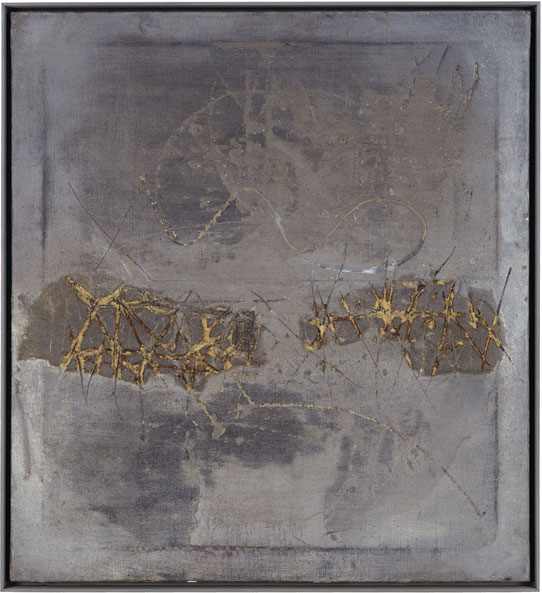Antoni Tàpies - Nr. XLVII
Nr. XLVII, 1957
Mischtechnik auf Leinwand
110 x 100 cm
Sammlung Im Obersteg, Depositum im Kunstmuseum Basel
Inv. Im 1551
Zurzeit nicht ausgestellt
Antoni Tàpies was an indefatigable experimentalist, trying out a wide variety of materials. The collage and the “objet trouvé” are the defining genres of his early oeuvre. A stay in Paris in 1950 brought a major shift in his art: he now worked with sand, clay, marble dust, or plaster, which he mixed with pigments and bone glue. He then applied this mass to the canvas in thick layers that he modeled as though for a relief and scratched up to obtain tactile surfaces. The resulting “pictures,” which might be mistaken for weathered masonry, exhibit the material as the true vessel of meaning. The artist himself called these works “wall paintings.” Encouraging associations of isolation, confinement, a Wailing Wall, and captivity, they speak to major concerns of their time.
Aufsatz Roland Wetzel, PDF, 125 KB
Provenance
1958 erworben bei der Galerie Ernst Beyeler, Basel, von Karl Im Obersteg
Literature
Agustí 1988-1992
Anna Agustí: Tàpies. The Complete Works, hrsg. von der Fundació Antoni Tàpies, 3 Bde., Barcelona und Köln 1988-1992, Bd. 1, S. 320, 533, Nr. 633, Abb.
Baumgartner/von Tavel 1995
Michael Baumgartner und Hans Christoph von Tavel: Die Sammlung Karl und Jürg Im Obersteg, hrsg. von der Stiftung «Sammlung Karl und Jürg Im Obersteg», Bern, Bern: Benteli Verlag, 1995, S. 217-219, Nr. 152, Abb. (Composition en gris)
Exhibitions
Bern 1975
Sammlung Im Obersteg, bearb. von Hugo Wagner, hrsg. von Kunstmuseum Bern, 25. Juni-14. Sept. 1975, Nr. 84, Abb. (Composition en gris)
Wien 2003
Im Banne der Moderne: Picasso, Chagall, Jawlensky, BA-CA Kunstforum, Wien, 4. Sept.-30. Nov. 2003, Nr. 73
Basel 2004
Die Sammlung Im Obersteg im Kunstmuseum Basel. Picasso, Chagall, Jawlensky, Soutine, Kunstmuseum Basel, 14. Febr.-2. Mai 2004, hrsg. von der Stiftung Im Obersteg, Basel: Schwabe Verlag, 2004, Nr. 180
